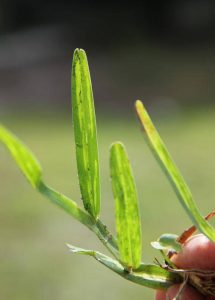Mosaic viruses are plant viruses that infect more than 150 types of plants. Symptoms show as mottled, blotchy or streaky patterns of yellow and green. In many cases plants may also be stunted. SCMV was named for the first host where it was found, sugarcane. Currently, it is not a problem for sugarcane producers as resistant sugarcane varieties are produced. However, a virus can change and overcome resistance.
Sugarcane mosaic disease of St. Augustinegrass is a mosaic virus. It was first reported in the 1960s in rural Palm Beach County sugarcane production areas. The disease seemed to disappear when resistant sugarcane varieties were developed with fewer than five positive samples identified by UF turfgrass pathologists between 2003-2013.
New Outbreaks in Florida

Beginning in 2013, outbreaks were identified in Pinellas County and Palm Beach County. Symptoms include the leaf mosaic pattern, but leaves also become necrotic (turn brown and die prematurely). According to Phil Harmon, UF/IFAS Plant Diagnostic Center, symptoms present as blotchy or streaky patterns of yellow and green color. Turfgrass tends to have broken yellow streaks running between the veins on an otherwise green blade. Symptoms of recently reported cases include mosaic, but then turn necrotic. The symptoms and dieback typically start in the fall months of September and October, and continue through the winter into spring. Some lawns may appear to recover in the spring. Unfortunately, lawns that appear to recover eventually die over a period of 1-3 years. Infected lawns may completely dieback.
How SCMV Spreads and Prevention
SCMV is transmitted by a number of means. The most efficient means of spreading the disease is mechanical. Lawn equipment such as lawn mowers and string trimmers can transfer sap and sap containing clippings from lawn to lawn. Good sanitation practices are very important to prevent this disease from becoming more widespread. Cleaning, or at a minimum drying and blowing off equipment before leaving one site to travel to another site, will help prevent disease spread. In areas where the disease is known to occur, potentially contaminated equipment parts should be cleaned and sprayed down using dilute bleach, quaternary ammonia, alcohol or other appropriate cleaning agent. SCMV has not been found at sod farms in Florida. Aphids also transmit the virus, but may not be an important vector in the lawn industry.
Lawn Replacement
St. Augustine ‘Floratam’ turfgrass has exhibited the most severe symptoms. ‘Floratam’ lawns that have died due to SCMV are susceptible to dying again if replaced with ‘Floratam’. The current recommendation is to replace lawns that have died as a result of SCMV with a more resistant turfgrass. ‘Palmetto’ and ‘Bitterblue’ are more resistant, but may still get the disease. Zoysiagrass is not known to be a host of SCMV. Although other grasses such as bermudagrass, seashore paspalum and bahiagrass have been reported with SCMV infections, St. Augustine is the only turfgrass of concern in Florida at this time.
Management
There are no known pesticides or other products that homeowners or landscape professionals can apply to lawns to prevent the development, spread or cure the disease. The severity varies from lawn to lawn and may be minor yellowing to death. Sod replacement, plugging with resistant varieties, or replacing lawn areas with alternative plant material or landscape elements are the only landscape options available.
Reporting and Diagnosis of SCMV
Other diseases may be causing problems in the lawn. Managing other disease problems has not been shown to impact SCMV. Therefore, it is important to correctly identify the disease causing the problem. Tracking the spread of SCMV in Florida is very important to determine the means of transmission and any changes in resistance. If you suspect that your lawn is affected by SCMV submit a sample to your local UF/IFAS Extension office or to the UF/IFAS Plant Diagnostic Center. For information on how to collect and submit a sample go to: http://plantpath.ifas.ufl.edu/Clinic/index.shtml. Check the Rapid Turfgrass Diagnostic Service Facebook page at https://www.facebook.com/RapidTurfgrassDiagnosticService for up-to-date information on the spread of this disease.
 0
0
